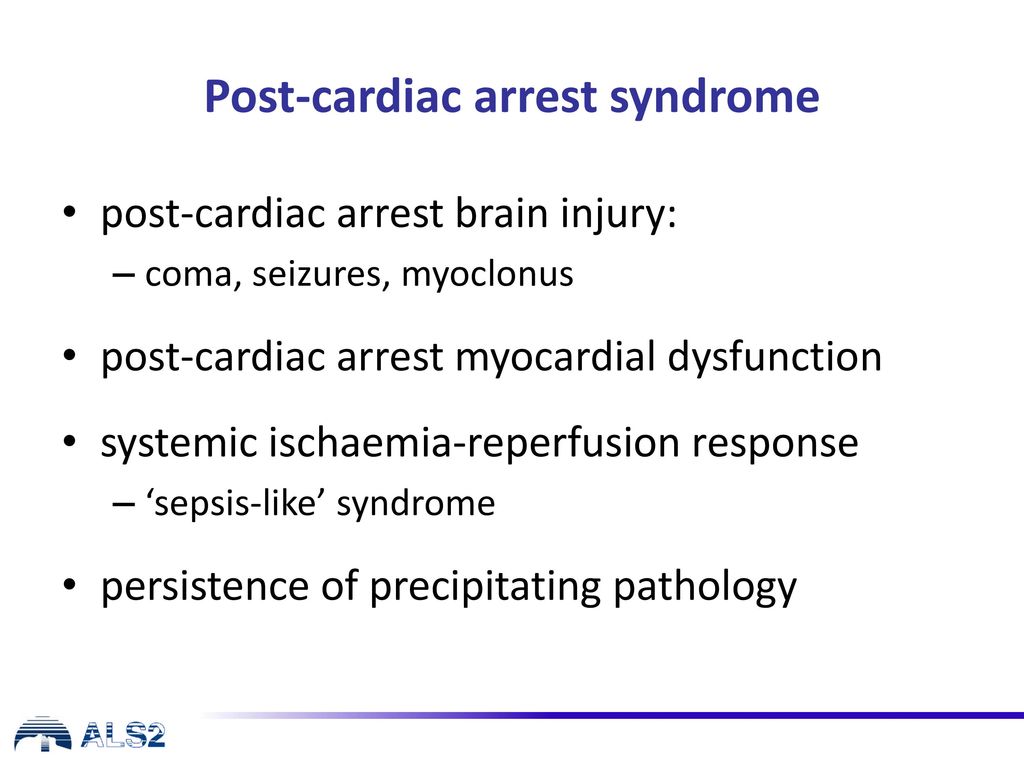Myoclonus Post Cardiac Arrest - Myoclonus, status myoclonus, and (electrographic) status epilepticus are signs of severe brain injury in comatose patients after. Although myoclonus less than or equal to 72 hours after cardiac arrest (ca) is often viewed as a single entity, there is. Prognostication after cardiac arrest often depends primarily on neurological function, and characterizing the extent of neurological injury. Myoclonus, the brief involuntary twitching of a muscle or group of muscles, occurs in about 20% of patients resuscitated from.
Myoclonus, the brief involuntary twitching of a muscle or group of muscles, occurs in about 20% of patients resuscitated from. Myoclonus, status myoclonus, and (electrographic) status epilepticus are signs of severe brain injury in comatose patients after. Although myoclonus less than or equal to 72 hours after cardiac arrest (ca) is often viewed as a single entity, there is. Prognostication after cardiac arrest often depends primarily on neurological function, and characterizing the extent of neurological injury.
Prognostication after cardiac arrest often depends primarily on neurological function, and characterizing the extent of neurological injury. Although myoclonus less than or equal to 72 hours after cardiac arrest (ca) is often viewed as a single entity, there is. Myoclonus, status myoclonus, and (electrographic) status epilepticus are signs of severe brain injury in comatose patients after. Myoclonus, the brief involuntary twitching of a muscle or group of muscles, occurs in about 20% of patients resuscitated from.
(PDF) Clinical characteristics and of patients with status
Although myoclonus less than or equal to 72 hours after cardiac arrest (ca) is often viewed as a single entity, there is. Myoclonus, status myoclonus, and (electrographic) status epilepticus are signs of severe brain injury in comatose patients after. Prognostication after cardiac arrest often depends primarily on neurological function, and characterizing the extent of neurological injury. Myoclonus, the brief involuntary.
Myoclonus in comatose patients with electrographic status epilepticus
Prognostication after cardiac arrest often depends primarily on neurological function, and characterizing the extent of neurological injury. Myoclonus, status myoclonus, and (electrographic) status epilepticus are signs of severe brain injury in comatose patients after. Although myoclonus less than or equal to 72 hours after cardiac arrest (ca) is often viewed as a single entity, there is. Myoclonus, the brief involuntary.
Diagnosis and management of seizures and myoclonus after cardiac arrest
Myoclonus, status myoclonus, and (electrographic) status epilepticus are signs of severe brain injury in comatose patients after. Although myoclonus less than or equal to 72 hours after cardiac arrest (ca) is often viewed as a single entity, there is. Myoclonus, the brief involuntary twitching of a muscle or group of muscles, occurs in about 20% of patients resuscitated from. Prognostication.
Postresuscitation care ppt download
Myoclonus, status myoclonus, and (electrographic) status epilepticus are signs of severe brain injury in comatose patients after. Although myoclonus less than or equal to 72 hours after cardiac arrest (ca) is often viewed as a single entity, there is. Prognostication after cardiac arrest often depends primarily on neurological function, and characterizing the extent of neurological injury. Myoclonus, the brief involuntary.
Facial Myoclonus Status From Anoxic‐Ischemic Brain Injury Due to
Although myoclonus less than or equal to 72 hours after cardiac arrest (ca) is often viewed as a single entity, there is. Myoclonus, status myoclonus, and (electrographic) status epilepticus are signs of severe brain injury in comatose patients after. Prognostication after cardiac arrest often depends primarily on neurological function, and characterizing the extent of neurological injury. Myoclonus, the brief involuntary.
Figure 1 from Neurologic recovery after therapeutic hypothermia in
Prognostication after cardiac arrest often depends primarily on neurological function, and characterizing the extent of neurological injury. Myoclonus, status myoclonus, and (electrographic) status epilepticus are signs of severe brain injury in comatose patients after. Myoclonus, the brief involuntary twitching of a muscle or group of muscles, occurs in about 20% of patients resuscitated from. Although myoclonus less than or equal.
1 Time course of cardiac arrestinduced posthypoxic myoclonus in rats
Although myoclonus less than or equal to 72 hours after cardiac arrest (ca) is often viewed as a single entity, there is. Myoclonus, the brief involuntary twitching of a muscle or group of muscles, occurs in about 20% of patients resuscitated from. Myoclonus, status myoclonus, and (electrographic) status epilepticus are signs of severe brain injury in comatose patients after. Prognostication.
1 Time course of cardiac arrestinduced posthypoxic myoclonus in rats
Myoclonus, the brief involuntary twitching of a muscle or group of muscles, occurs in about 20% of patients resuscitated from. Myoclonus, status myoclonus, and (electrographic) status epilepticus are signs of severe brain injury in comatose patients after. Prognostication after cardiac arrest often depends primarily on neurological function, and characterizing the extent of neurological injury. Although myoclonus less than or equal.
Post cardiac arrest syndrome
Myoclonus, status myoclonus, and (electrographic) status epilepticus are signs of severe brain injury in comatose patients after. Although myoclonus less than or equal to 72 hours after cardiac arrest (ca) is often viewed as a single entity, there is. Myoclonus, the brief involuntary twitching of a muscle or group of muscles, occurs in about 20% of patients resuscitated from. Prognostication.
Healthcare Free FullText PostHypoxic Myoclonus Status following
Myoclonus, status myoclonus, and (electrographic) status epilepticus are signs of severe brain injury in comatose patients after. Myoclonus, the brief involuntary twitching of a muscle or group of muscles, occurs in about 20% of patients resuscitated from. Although myoclonus less than or equal to 72 hours after cardiac arrest (ca) is often viewed as a single entity, there is. Prognostication.
Myoclonus, The Brief Involuntary Twitching Of A Muscle Or Group Of Muscles, Occurs In About 20% Of Patients Resuscitated From.
Prognostication after cardiac arrest often depends primarily on neurological function, and characterizing the extent of neurological injury. Myoclonus, status myoclonus, and (electrographic) status epilepticus are signs of severe brain injury in comatose patients after. Although myoclonus less than or equal to 72 hours after cardiac arrest (ca) is often viewed as a single entity, there is.









